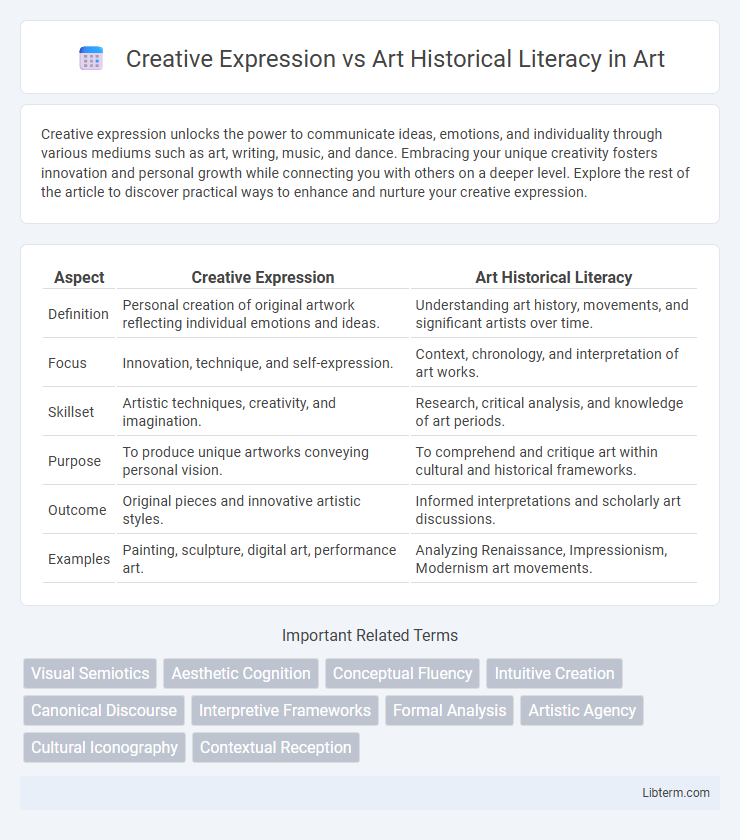Creative expression unlocks the power to communicate ideas, emotions, and individuality through various mediums such as art, writing, music, and dance. Embracing your unique creativity fosters innovation and personal growth while connecting you with others on a deeper level. Explore the rest of the article to discover practical ways to enhance and nurture your creative expression.
Table of Comparison
| Aspect | Creative Expression | Art Historical Literacy |
|---|---|---|
| Definition | Personal creation of original artwork reflecting individual emotions and ideas. | Understanding art history, movements, and significant artists over time. |
| Focus | Innovation, technique, and self-expression. | Context, chronology, and interpretation of art works. |
| Skillset | Artistic techniques, creativity, and imagination. | Research, critical analysis, and knowledge of art periods. |
| Purpose | To produce unique artworks conveying personal vision. | To comprehend and critique art within cultural and historical frameworks. |
| Outcome | Original pieces and innovative artistic styles. | Informed interpretations and scholarly art discussions. |
| Examples | Painting, sculpture, digital art, performance art. | Analyzing Renaissance, Impressionism, Modernism art movements. |
Defining Creative Expression
Creative expression involves the personal articulation of ideas, emotions, and imagination through various mediums such as painting, music, dance, or writing. It emphasizes originality and the unique voice of the creator without necessarily relying on formal knowledge of art history. This contrasts with art historical literacy, which prioritizes understanding the context, techniques, and significance of artworks within cultural and historical frameworks.
Understanding Art Historical Literacy
Understanding art historical literacy involves recognizing the cultural, social, and political contexts that shape artistic movements and individual works. It requires knowledge of key art periods, influential artists, and the evolution of styles to critically analyze and interpret visual art. This literacy enhances appreciation by connecting creative expression to historical narratives and theoretical frameworks.
The Intersection of Creation and Knowledge
Creative expression thrives on personal interpretation and imaginative freedom, while art historical literacy anchors that creativity in context through understanding stylistic movements, cultural influences, and artist intentions. The intersection of creation and knowledge enhances artistic depth, allowing creators to innovate informed by historical evolution and theoretical frameworks. This synergy enriches both the production and appreciation of art, bridging subjective experience with critical analysis.
Creativity Without Historical Boundaries
Creative expression thrives when freed from art historical literacy constraints, allowing artists to explore innovation without predefined rules. Emphasizing creativity without historical boundaries fosters unique interpretations and novel mediums that challenge traditional art paradigms. This approach encourages a dynamic artistic landscape driven by individual vision rather than adherence to established art movements or periods.
Art History as a Foundation for Innovation
Art history serves as a critical foundation for innovation by providing artists with a deep understanding of cultural contexts, styles, and techniques that inform creative expression. Mastery of art historical knowledge enables creators to reinterpret traditional motifs and themes, fostering originality rooted in a rich visual and conceptual heritage. This interplay between art historical literacy and creative practice drives forward innovation within the contemporary art landscape.
Debates: Originality vs. Tradition
Debates surrounding creative expression versus art historical literacy often center on the tension between originality and tradition, where originality champions innovation and personal voice while tradition emphasizes continuity with established artistic conventions. Contemporary artists negotiate this balance by integrating historical techniques and references with new media and concepts to create works that resonate within and beyond art historical contexts. The discourse reflects broader cultural dialogues about the value of preserving heritage while fostering artistic evolution in a globalized art world.
The Role of Education in Artistic Development
Education plays a crucial role in balancing creative expression and art historical literacy by providing students with both technical skills and contextual knowledge. Understanding art history enhances creative expression by offering inspiration and critical frameworks that deepen artistic meaning. Integrating hands-on practice with art historical study fosters well-rounded artistic development, promoting innovation grounded in cultural awareness.
Impact on Audience Perception
Creative expression engages audiences through emotional resonance and personal interpretation, fostering a dynamic, subjective experience. Art historical literacy provides contextual frameworks that deepen understanding of an artwork's significance, style, and cultural background, guiding viewers toward informed appreciation. The interplay between these approaches shapes audience perception by balancing intuitive connection with critical insight, enhancing both emotional impact and intellectual engagement.
Balancing Personal Voice with Historical Context
Balancing personal voice with historical context requires artists to integrate creative expression while respecting art historical literacy, ensuring their work resonates with both individuality and tradition. Emphasizing knowledge of art movements, techniques, and cultural influences enriches the creative process by grounding personal narratives within a broader historical framework. This fusion cultivates a dynamic dialogue between contemporary innovation and classical foundations, enhancing the depth and relevance of artistic output.
The Future of Art: Integration or Division?
The future of art hinges on the balance between creative expression and art historical literacy, where integration fosters innovative works anchored in cultural context, enriching meaning and relevance. Diverging paths may lead to division, with creative expression prioritizing individual originality, while art historical literacy emphasizes continuity and collective understanding. Embracing a symbiotic relationship between both elements could drive art's evolution, blending tradition with contemporary perspectives for dynamic cultural dialogues.
Creative Expression Infographic

 libterm.com
libterm.com